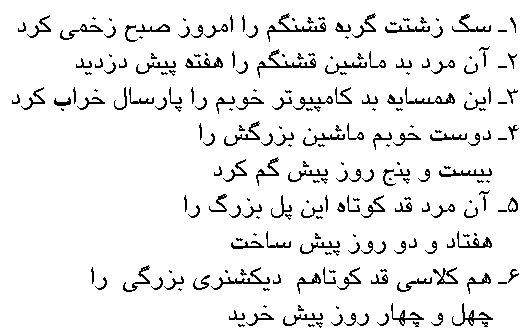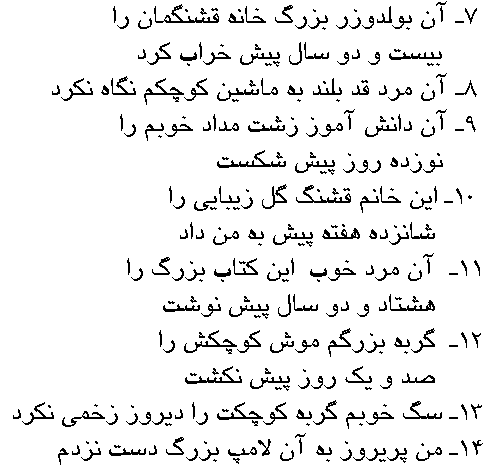As you know, practice makes perfect! These useful drills present even more new words for you to add to this week’s lesson. This will not only build your Persian vocabulary, but also help you learn to read and write Farsi more quickly and confidently.
Note: Before doing these homeworks, make sure you have learned the previous words fluently.
New words:
Zakhmi kardanTo break (here) = ![]() /khæra:b kærdæn/.
/khæra:b kærdæn/.
To lose (here) = ![]() /gom kærdæn/.
/gom kærdæn/.
Short man = ![]() /mærd-e- ghæd ku:ta:h/.
/mærd-e- ghæd ku:ta:h/.
My short classmate = ![]() /hæm kela:si: ye ghæd ku:ta:hæm/.
/hæm kela:si: ye ghæd ku:ta:hæm/.
To destroy = ![]() /khæra:b kærdæn/.
/khæra:b kærdæn/.
To give somebody something = /something ra: beh somebody da:dæn/. He gave me that book three days ago. /u: a:n keta:b ra: seh ru:z-e- pish beh mæn da:d/.
To write = /neveshtæn/.
LampPlease translate the following sentences into Persian.
You already know how to use the rule. You may find the answers below.
- Your ugly dog hurt my beautiful cat this morning.
- That bad man stole my beautiful car last week.
- This bad neighbor broke my good computer last year.
- My good friend lost his big car 25 days ago.
- That short man built this big bridge 72 days ago.
- My short classmate bought a big dictionary 44 days ago.
- That big bulldozer destroyed our beautiful house 22 years ago.
- That tall man didn’t look at my small car.
- That ugly student broke my good pencil 19 days ago.
- This beautiful lady gave me a beautiful flower 16 weeks ago.
- That good man wrote this big book 82 years ago.
- My big cat didn’t kill her small mouse 101 days ago.
- My good dog didn’t hurt your small cat yesterday.
- I didn’t touch that big light the day before yesterday.


mm14
May 22, 2013 @ 2:39 am
Please remind me – in question 14, why is there no ra after lamp-e-bozorg?
Debora Lutz
June 11, 2013 @ 10:50 am
I think it’s because the verb, to touch “something”, beh…dast zadan, has the preposition beh. It is my understanding that verbs with prepositions do not take ra.
Debora Lutz
June 11, 2013 @ 10:14 am
Hassan, I am enjoying your lessons so much. You teach very well. I may not always remember the vocabulary, but I am getting the grammar. Thank you :)
Debora Lutz
June 11, 2013 @ 10:24 am
Broken link: lamp, lesson 23.
Debora Lutz
June 11, 2013 @ 10:29 am
And man khanehi ra forukhtam.
Debora Lutz
June 11, 2013 @ 10:34 am
Never mind. It’s OK.
Elie Mouhanna
June 28, 2014 @ 4:50 pm
Salam Hassan,
One small detail is confusing me in this exercise: In the tenth sentence, why did you write گل زیبایی and not گل زیبا ای? I’m only confused because, based on what I understood, زیبای is a noun meaning “beauty,” and not an adjective. Is there some point I’m missing here here?
Motaeshaekeram,
Elie
Nathan M
July 30, 2014 @ 4:34 pm
Do you explain somewhere, why you use shaekaestan instead of karab kardan in number 9? In which instances should we use either one? I cannot find the lesson where shaekaestan was introduced.
Shakir Moledina
June 23, 2015 @ 2:17 pm
I can try.
Shekastan is to break while kharab kardan is to damage/destroy
Shakir Moledina
June 23, 2015 @ 2:41 pm
I forgot to add that you cannot break a computer but you rather destroy it. Contextually you can “imagine” it in that way.
Do not be too technical about hit your head about it
elie
July 9, 2015 @ 8:06 am
why at sentence number 6 you answer ” dictionary bozorgi ” ?
whenever, it is ” buldozer bozorg ” vith no y sound at the end!
why yhis y sound?
mohammad mj
July 16, 2015 @ 12:25 pm
because in number 6 you have “a” big dictionary so you have to use “yek” before dictionary or add “i” to the end of bozorg to translate the “a” but in number 7 you have “that” big bulldozer not “a” big bulldozer so you don’t need to use “yek” or “i”.you just have to say “aan” for “that”.